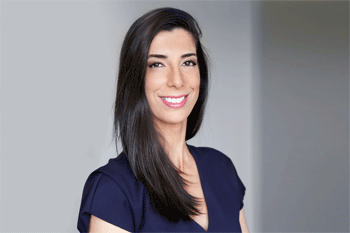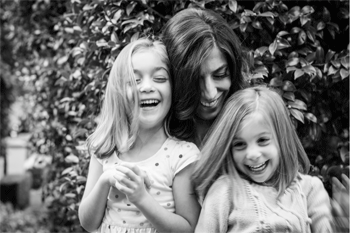Nadine Ismiel-Nash How To Manage Nits Easily Interview

Nadine Ismiel-Nash How To Manage Nits Easily Interview
Did you know it's a complete myth that head lice are notoriously difficult to eradicate from your home? There's actually an easy process to follow, with many families successfully reducing the risk of infestation time and time again. Effectively getting rid of head lice from the hair is only part of the solution and understanding how it is spread and where else they may live is a step towards annihilating this unwelcome critter.
These miniscule blood-suckers have a terrible reputation and can often make people feel gross but nits carry no diseases and have no bearing on your personal hygiene. There is a myth that they only like dirty hair but the truth is, they are not fussy. If you have hair, be it clean, dirty, coloured and gelled, you are at risk.
More than 95 per cent of head lice infestations are picked up at school through hair-to-hair contact with someone who already has lice. While everyone loves to cuddle, wrestle, and get in close for a -selfie', these are considered high-risk activities in the world of nits. This is why if one person in your family is infested with nits, the entire family must be checked and potentially treated or you may be at risk of re-infestation.
Once you have detected head lice in your home you must be fastidious in treating them. Head lice can only survive on the scalp, close to their favourite food source – your blood. The female louse can lay between 50 and 100 eggs (nits) in her 35-day life span. That's a lot of babies in a very short time, all living in your child's (or your) hair. If you miss some eggs in your treatment, and they hatch, you may have to go through the entire process again.
Nadine Ismiel-Nash, the mum and scientist who created Australia's #1 Head Lice treatment NitWits All-In-One, is urging Australian parents to remember that early detection and treatment of head lice will minimise the spread.
'For any child in school, including preschool and high school, weekly head lice checks are a MUST. Don't forget to do a good check behind the ears and at the base of the neck. Preventing head lice is easier and more pleasant for kids and parents, and a good routine will make it much less likely that your child will be affected.
'Secure long hair in a bun or a plait to minimise 'hair-to-hair' contact. Apply a repellent like the NitWits Anti-Lice & Detangling Spray to deter and defend against lice daily."
Nadine is the Head of Research and Development at Sue Ismiel & Daughters, the company that created the NitWits Head Lice range, which is pyrethroid-free. She says there are four types of head lice treatments available in Australia which work in all different ways, and knowing what these treatments do and what is most suitable for your child is important.
'For example, NitWits offers three different types of treatments: physically-acting treatments which work differently to chemically-acting treatments through a non-poisonous method to kill head lice and eggs; wet combing which involves a combing solution and lice comb to comb out the lice and eggs; and natural treatments that use natural actives such as tea tree and eucalyptus oils to treat lice by entering the louse's central nervous system, paralysing and killing the lice," she explains.
But to ensure they don't come back, you need to ensure everyone around your child has the all-clear too.
'It's incredibly important for you to communicate with your child's school if head lice are discovered in your child's hair. Also, inform friends and family so they can check for head lice as well. This is the only way all potential sources of infestation can be eliminated," adds Nadine.
For more information about NitWits All-in-One Head Lice Treatment - an effective, pyrethroid-free treatment that is Australia's #1 Head Lice product - visit www.nitwitsforkids.com
 Interview with Nadine Ismiel-Nash
Interview with Nadine Ismiel-Nash
Nadine Ismiel-Nash, a scientist and mum to two young children (with one on the way!), is the founder and creator of the highly successful Australian head lice treatment range, NitWits. The NitWits range includes Australia's #1 head lice treatment1, NitWits All-In-One and all products in the range are pyrethroid-free.
Nadine has a passion for creating products with a difference, which is why she developed NitWits All-In-One. As a scientist and mother, she recognises parents want the best for their kids, particularly when it comes to their health and safety, so she made it her mission to provide a safe, gentle and easy to use head lice product.
Nadine focuses on educating parents and healthcare professionals, including pharmacists, on the most effective – and efficient - way to deal with head lice infestations.
Nadine is also the Executive Director of global company, Sue Ismiel & Daughters, where she heads the Research and Development teams. Sue Ismiel & Daughters is the parent company for brands including Nad's Hair Removal, NitWits, Wyld and Australian Native Botanicals.
Question: What are nits?
Nadine Ismiel-Nash: The head lice family consists of nits (empty egg shells), eggs (unhatched eggs) and lice (nymphs, which are adolescent lice and adult lice). Newly laid eggs are semi-transparent. As the embryo matures the egg starts to become slightly brownish. Nits appear whitish. Adult lice are grey or light-brown in colour. Head lice feed from the human scalp and can grow to 4mm long. They do have a terrible reputation, but there's really nothing to worry about as they do not carry any diseases and have no bearing on your personal hygiene.
Question: How are nits spread?
Nadine Ismiel-Nash: The fact is more than 95 per cent of head lice infestations are picked up at school through hair-to-hair contact with someone who already has lice. If your child cuddles with someone who has nits, play and wrestle with them, or something as simple as taking a photo together all increase their chances of catching head lice. It's a common myth that head lice can jump. They actually crawl from hair-to-hair. It's also good to secure long hair in a bun or a plait to minimise hair-to-hair contact. Apply a repellent like the NitWits Anti-Lice & Detangling Spray to deter and defend against lice daily.
Question: At what age are nits, most common?
Nadine Ismiel-Nash: Children of all ages are prone to head lice, but most cases come from school including preschool and high school. It's best to be prepared and check your children regularly for head lice, as the earlier you treat them the better.
Question: What are the symptoms associated with nits?
Nadine Ismiel-Nash: While most often the first symptom is an itchy head, unfortunately not all cases are as easily detectable with some not feeling any itch at all! Instead, I encourage parents to make it a habit, part of the weekly routine to check for head lice just in case.
Question: How often should parents perform it checks?
Nadine Ismiel-Nash: I strongly recommend for parents to check for head lice weekly. Don't forget to do a good check behind the ears and at the base of the neck. Preventing head lice is easier and more pleasant for kids and parents, and a good routine will make it much less likely that your child will be affected.
Question: And, what is the best process for a nit-check?
Nadine Ismiel-Nash: There's an easy 3-step process I advise parents to follow when checking for head lice. First, coat the hair thoroughly with a thick white conditioner or a solution especially formulated for combing out nits and head lice like NitWits Combing Solution. Note: take a moment to check the base of the neck and behind the ears – head lice will often run to these areas first when they're disturbed. Second, divide the hair down the centre of the head and secure one side of the hair with a clip. Lastly, start from the base of the neck, divide the loose hair into 4cm wide sections and comb through the hair with a specialised nit comb from root to tip. Wipe the comb with a tissue and repeat, working your way toward the front of the head. Repeat on the other side to ensure all hair has been combed. It's as simple as that!
Question: Why are nits so difficult to eradicate?
Nadine Ismiel-Nash: This is actually a complete myth, as they're not difficult to eradicate at all! It's not necessary to disinfect the entire home, as I know many feel believe they need to, but it's just not the case. The important thing is to be fastidious in treating them and treat them properly the first time. Head lice can only survive on the scalp, close to their favourite food source – your blood.
Question: How can we manage nits, easily?
Nadine Ismiel-Nash: There are four types of head lice treatments available in Australia which work in all different ways, and knowing what these treatments do and what is most suitable for your child is important. NitWits offers three different types of treatments: physically-acting treatments which work differently to chemically-acting treatments through a non-poisonous method to kill head lice and eggs; wet combing which involves a combing solution and lice comb to comb out the lice and eggs; and natural treatments that use natural actives such as tea tree and eucalyptus oils to treat lice by entering the louse's central nervous system, paralysing and killing the lice. It's also incredibly important for you to communicate with your child's school if head lice are discovered in your child's hair. Also, inform friends and family so they can check for head lice as well. This is the only way all potential sources of infestation can be eliminated.
Question: Can you share with us 10 things we might not know, about nits?
Nadine Ismiel-Nash: They're quite fascinating critters!
1. They are very fast crawlers; you may not see them doing a -dry' head check.
2. They cannot live away from the scalp. They dehydrate and die within 24 hrs.
3. They cannot be transmitted through linen and towels.
4. Head lice need to feed approximately 6 times a day.
5. Louse eggs (nits) cannot develop below approximately 28oC, i.e. away from the scalp.
6. Head lice cannot jump, fly or swim; instead they crawl from your hair.
7. Not everyone gets a head itch.
8. Adult lice can grow to 4mm long but the nits may be as small as a grain of salt.
9. Female lice lay between 50 and 100 eggs in their lifetime.
10. NitWits All-In-One is Australia's #1 head lice treatment that kills lice and their eggs in one treatment.
Interview by Brooke Hunter
MORE



